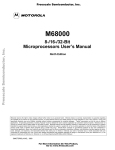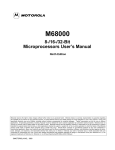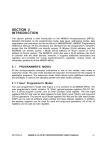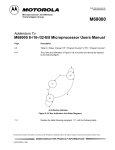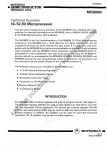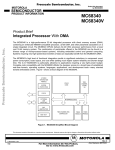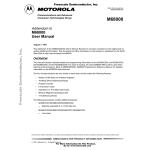Download section 3 signal description
Transcript
31 16 15 8 7 0 D0 D1 D2 D3 EIGHT DATA REGISTERS D4 D5 D6 D7 31 16 15 0 A0 A1 A2 SEVEN ADDRESS REGISTERS A3 A4 A5 A6 A7 USER STACK (USP) POINTER 31 0 7 PC PROGRAM COUNTER CCR STATUS REGISTER 0 Figure 2-1. User Programmer's Model (MC68000/MC68HC000/MC68008/MC68010) 2.1.2 Supervisor Programmer's Model The supervisor programmer's model consists of supplementary registers used in the supervisor mode. The M68000 MPUs contain identical supervisor mode register resources, which are shown in Figure 2-2, including the status register (high-order byte) and the supervisor stack pointer (SSP/A7'). 31 16 15 0 A7' SUPERVISOR STACK (SSP) POINTER 15 8 7 0 CCR SR STATUS REGISTER Figure 2-2. Supervisor Programmer's Model Supplement The supervisor programmer's model supplement of the MC68010 is shown in Figure 23. In addition to the supervisor stack pointer and status register, it includes the vector base register (VRB) and the alternate function code registers (AFC).The VBR is used to determine the location of the exception vector table in memory to support multiple vector 2-2 M68000 8-/16-/32-BIT MICROPROCESSOR USER’S MANUAL MOTOROLA tables. The SFC and DFC registers allow the supervisor to access user data space or emulate CPU space cycles. 31 16 15 15 0 8 7 A7' (SSP) SUPERVISOR STACK POINTER SR STATUS REGISTER VBR VECTOR BASE REGISTER SFC ALTERNATE FUNCTION CODE REGISTERS 0 CCR 31 0 2 0 DFC Figure 2-3. Supervisor Programmer's Model Supplement (MC68010) 2.1.3 Status Register The status register (SR),contains the interrupt mask (eight levels available) and the following condition codes: overflow (V), zero (Z), negative (N), carry (C), and extend (X). Additional status bits indicate that the processor is in the trace (T) mode and/or in the supervisor (S) state (see Figure 2-4). Bits 5, 6, 7, 11, 12, and 14 are undefined and reserved for future expansion SYSTEM BYTE 15 13 T S USER BYTE 10 8 I2 I1 I0 4 X 0 N Z V C TRACE MODE EXTEND NEGATIVE ZERO OVERFLOW CARRY SUPERVISOR STATE INTERRUPT MASK CONDITION CODES Figure 2-4. Status Register 2.2 DATA TYPES AND ADDRESSING MODES The five basic data types supported are as follows: 1. Bits 2. Binary-Coded-Decimal (BCD) Digits (4 Bits) 3. Bytes (8 Bits) 4. Words (16 Bits) 5. Long Words (32 Bits) MOTOROLA M68000 8-/16-/32-BIT MICROPROCESSOR USER’S MANUAL 2-3 SECTION 3 SIGNAL DESCRIPTION This section contains descriptions of the input and output signals. The input and output signals can be functionally organized into the groups shown in Figure 3-1 (for the MC68000, the MC68HC000 and the MC68010), Figure 3-2 ( for the MC68HC001), Figure 3-3 (for the MC68EC000), Figure 3-4 (for the MC68008, 48-pin version), and Figure 3-5 (for the MC68008, 52-pin version). The following paragraphs provide brief descriptions of the signals and references (where applicable) to other paragraphs that contain more information about the signals. NOTE The terms assertion and negation are used extensively in this manual to avoid confusion when describing a mixture of "active-low" and "active-high" signals. The term assert or assertion is used to indicate that a signal is active or true, independently of whether that level is represented by a high or low voltage. The term negate or negation is used to indicate that a signal is inactive or false. VCC(2) GND(2) ADDRESS BUS A23–A1 CLK DATA BUS D15–D0 PROCESSOR STATUS FC0 FC1 FC2 AS R/W UDS LDS DTACK ASYNCHRONOUS BUS CONTROL MC6800 PERIPHERAL CONTROL E VMA VPA BR BG BGACK BUS ARBITRATION CONTROL SYSTEM CONTROL BERR RESET HALT IPL0 IPL1 IPL2 INTERRUPT CONTROL Figure 3-1. Input and Output Signals (MC68000, MC68HC000 and MC68010) MOTOROLA M68000 8-/16-/32-BIT MICROPROCESSORS USER'S MANUAL 3-1 Table 3-3. Function Code Outputs Function Code Output FC2 FC1 FC0 Address Space Type Low Low Low (Undefined, Reserved) Low Low High User Data Low High Low User Program Low High High (Undefined, Reserved) High Low Low (Undefined, Reserved) High Low High Supervisor Data High High Low Supervisor Program High High High CPU Space 3.9 CLOCK (CLK) The clock input is a TTL-compatible signal that is internally buffered for development of the internal clocks needed by the processor. This clock signal is a constant frequency square wave that requires no stretching or shaping. The clock input should not be gated off at any time, and the clock signal must conform to minimum and maximum pulse-width times listed in Section 10 Electrical Characteristics. 3.10 POWER SUPPLY (V CC and GND) Power is supplied to the processor using these connections. The positive output of the power supply is connected to the VCC pins and ground is connected to the GND pins. MOTOROLA M68000 8-/16-/32-BIT MICROPROCESSORS USER'S MANUAL 3-9 3.11 SIGNAL SUMMARY Table 3-4 summarizes the signals discussed in the preceding paragraphs. Table 3-4. Signal Summary Hi-Z Signal Name Input/Output Active State Address Bus A0–A23 Output High Yes Yes Data Bus D0–D15 Input/Output High Yes Yes AS Output Low No Yes Read/Write R/ W Output Read-High Write-Low No Yes Data Strobe DS Output Low No Yes UDS, LDS Output Low No Yes DTACK Input Low No No Bus Request BR Input Low No No Bus Grant BG Output Low No No BGACK Input Low No No IPL 0, IPL 1, IPL 2 Input Low No No Bus Error BERR Input Low No No Mode MODE Input High — — Reset RESET Input/Output Low No* No* HALT Input/Output Low No* No* E Output High No No Valid Memory Address VMA Output Low No Yes Valid Peripheral Address VPA Input Low No No FC0, FC1, FC2 Output High No Yes Clock CLK Input High No No Power Input VCC Input — — — Ground GND Input — — — Address Strobe Upper and Lower Data Strobes Data Transfer Acknowledge Bus Grant Acknowledge Interrupt Priority Level Halt Enable Function Code Output On HALT Mnemonic On Bus Relinquish *Open drain. 3-10 M68000 8-/16-/32-BIT MICROPROCESSORS USER'S MANUAL MOTOROLA 4. For an MC68010, return DTACK before data verification. If data is invalid, assert BERR on the next clock cycle (case 4). Table 5-6. BERR and HALT Negation Results Negated on Rising Edge of State Conditions of Termination in Table 4-4 Control Signal N Bus Error BERR HALT • • or or • • Takes bus error trap. Rerun BERR HALT • • or • Illegal sequence; usually traps to vector number 0. Rerun BERR HALT • BERR HALT • • or • BERR HALT • or • none Normal Normal N+2 Results—Next Cycle Reruns the bus cycle. • May lengthen next cycle. If next cycle is started, it will be terminated as a bus error. • = Signal is negated in this bus state. 5.7 ASYNCHRONOUS OPERATION To achieve clock frequency independence at a system level, the bus can be operated in an asynchronous manner. Asynchronous bus operation uses the bus handshake signals to control the transfer of data. The handshake signals are AS, UDS, LDS, DS (MC68008 only), DTACK, BERR, HALT, AVEC (MC68EC000 only), and VPA (only for M6800 peripheral cycles). AS indicates the start of the bus cycle, and UDS, LDS, and DS signal valid data for a write cycle. After placing the requested data on the data bus (read cycle) or latching the data (write cycle), the slave device (memory or peripheral) asserts DTACK to terminate the bus cycle. If no device responds or if the access is invalid, external control logic asserts BERR, or BERR and HALT, to abort or retry the cycle. Figure 5-31 shows the use of the bus handshake signals in a fully asynchronous read cycle. Figure 5-32 shows a fully asynchronous write cycle. ADDR AS R/W UDS/LDS DATA DTACK Figure 5-31. Fully Asynchronous Read Cycle 5-32 M68000 8-/16-/32-BIT MICROPROCESSORS USER'S MANUAL MOTOROLA ADDR AS R/W UDS/LDS DATA DTACK Figure 5-32. Fully Asynchronous Write Cycle In the asynchronous mode, the accessed device operates independently of the frequency and phase of the system clock. For example, the MC68681 dual universal asynchronous receiver/transmitter (DUART) does not require any clock-related information from the bus master during a bus transfer. Asynchronous devices are designed to operate correctly with processors at any clock frequency when relevant timing requirements are observed. A device can use a clock at the same frequency as the system clock (e.g., 8, 10, or 12.5, 16, and 20MHz), but without a defined phase relationship to the system clock. This mode of operation is pseudo-asynchronous; it increases performance by observing timing parameters related to the system clock frequency without being completely synchronous with that clock. A memory array designed to operate with a particular frequency processor but not driven by the processor clock is a common example of a pseudo-asynchronous device. The designer of a fully asynchronous system can make no assumptions about address setup time, which could be used to improve performance. With the system clock frequency known, the slave device can be designed to decode the address bus before recognizing an address strobe. Parameter #11 (refer to Section 10 Electrical Characteristics) specifies the minimum time before address strobe during which the address is valid. In a pseudo-asynchronous system, timing specifications allow DTACK to be asserted for a read cycle before the data from a slave device is valid. The length of time that DTACK may precede data is specified as parameter #31. This parameter must be met to ensure the validity of the data latched into the processor. No maximum time is specified from the assertion of AS to the assertion of DTACK. During this unlimited time, the processor inserts wait cycles in one-clock-period increments until DTACK is recognized. Figure 5-33 shows the important timing parameters for a pseudo-asynchronous read cycle. MOTOROLA M68000 8-/16-/32-BIT MICROPROCESSORS USER'S MANUAL 5-33 Table 6-2. Exception Vector Assignment Vectors Numbers Address Hex Decimal Dec Hex Space 6 0 0 0 000 SP 1 1 4 004 SP Reset: Initial SSP2 Reset: Initial PC 2 2 2 8 008 SD Bus Error 3 3 12 00C SD Address Error 4 4 16 010 SD Illegal Instruction Assignment 5 5 20 014 SD Zero Divide 6 6 24 018 SD CHK Instruction 7 7 28 01C SD TRAPV Instruction 8 8 32 020 SD Privilege Violation 9 9 36 024 SD Trace A 10 40 028 SD Line 1010 Emulator B 11 44 02C SD Line 1111 Emulator C 48 030 SD (Unassigned, Reserved) D 121 131 52 034 SD (Unassigned, Reserved) E 14 56 038 SD Format Error 5 F 15 60 03C SD Uninitialized Interrupt Vector 10–17 16–231 64 040 SD (Unassigned, Reserved) 92 05C 18 24 96 060 SD Spurious Interrupt 3 19 25 100 064 SD Level 1 Interrupt Autovector — 1A 26 104 068 SD Level 2 Interrupt Autovector 1B 27 108 06C SD Level 3 Interrupt Autovector 1C 28 112 070 SD Level 4 Interrupt Autovector 1D 29 116 074 SD Level 5 Interrupt Autovector 1E 30 120 078 SD Level 6 Interrupt Autovector 1F 31 124 07C SD 20–2F 32–47 128 080 SD Level 7 Interrupt Autovector TRAP Instruction Vectors4 188 0BC 30–3F 48–631 192 0C0 SD (Unassigned, Reserved) 255 0FF 40–FF 64–255 256 100 1020 3FC — — SD User Interrupt Vectors — NOTES: 1. Vector numbers 12, 13, 16–23, and 48–63 are reserved for future enhancements by Motorola. No user peripheral devices should be assigned these numbers. 2. Reset vector (0) requires four words, unlike the other vectors which only require two words, and is located in the supervisor program space. 3. The spurious interrupt vector is taken when there is a bus error indication during interrupt processing. 4. TRAP #n uses vector number 32+ n. 5. MC68010 only. This vector is unassigned, reserved on the MC68000 and MC68008. 6. SP denotes supervisor program space, and SD denotes supervisor data space. MOTOROLA M68000 8-/16-/32-BIT MICROPROCESSORS USER’S MANUAL 6-7












